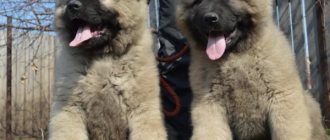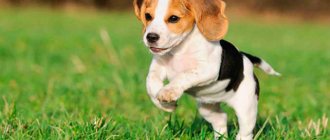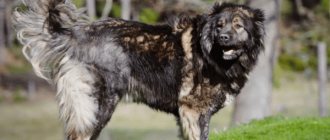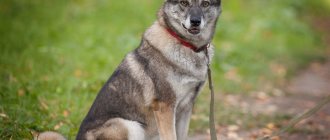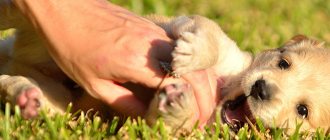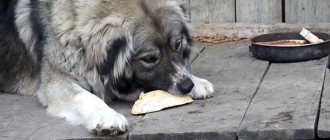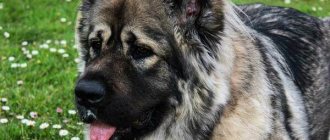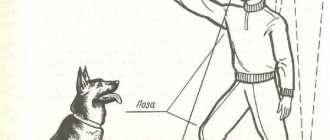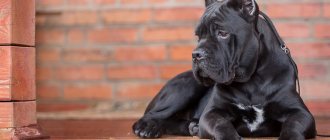The Caucasian Shepherd Dog or Wolfhound is a true example of equanimity, with a tough and capricious character. It is difficult for an owner to cope not only with an adult dog, but also with a puppy, because “Caucasians” develop leadership qualities already in childhood. Training a Caucasian Shepherd puppy is a difficult task, which, no matter what, will bring pleasant results.
Training the Caucasian Shepherd: features
When raising and training a little “Caucasian”, the owner needs to make every effort. But if you don’t choose the right approach to your pet, you can not only end up with a cruel dog, but also create problems for all family members and neighbors. Therefore, training must be approached with all responsibility: this is the only way to raise a devoted friend and reliable protector.
Happy Caucasian Shepherd puppy
Why is it so important to train a “Caucasian”?
The instincts that are inherited by the puppy from its parents are not enough for it to exist normally in human society. The Caucasian Shepherd is a protector and leader of the pack, who is always on the alert. He keeps everything under control and rushes to any threat without hesitation. There are not many real threats in our world, and a “Caucasian” can attack an ordinary passerby while walking if he senses that he is an enemy. To eliminate such mistakes, training is required. She helps:
- develop skills that will be useful for life in society;
- train your pet to perform certain tasks - protect a person or private territory, stand guard, monitor the herd;
- establish contact between the animal and the person: the dog learns to listen to the owner and trust him, and his owner learns to analyze the body language and mood of the pet.
The character of “Caucasians” does not allow them to obey their master unquestioningly: they definitely need to first think and analyze what is being asked of them. Therefore, it is very important to earn the pet’s trust, because training for “Caucasians” is extremely important.
The majestic “Caucasian” is resting
Is this breed easy to train?
The breed's character demonstrates persistence and determination, while high intelligence and restraint contribute to the dog's rapid learning.
Shepherds also have well-developed sensitivity and attentiveness. If the first encourages the pet to react to stimuli, showing distrust of unfamiliar things or acquaintances, then the second contributes to the rapid assimilation of commands.
NOTE!
Attention is one of the success factors in dog training and affects the ability to focus on the owner and follow his instructions.
However, the difficulty lies in choosing the right training method. Despite its good trainability, the Caucasian Shepherd is not without intelligence, which often does not play on the side of the owner.
Training at home: pros and cons
Those who decide to train a “Caucasian” at home will have to face a lot of problems.
- The temperament of “Caucasians” is not suitable for any general training course system - neither Russian nor foreign. Even canine practice does not provide effective programs for training “Caucasians”.
- The Caucasian Shepherd will not repeat the same command several times: representatives of the breed consider this an unnecessary waste of precious time. A four-legged animal of this breed will only respond to orders that seem appropriate to it. He cannot easily waste energy on nonsense, because he believes that it would be more useful to spend his energy on protecting his family and owner.
- Almost all wolfhounds do not have the retrieval reflex, since they do not need it for work. They will never perform demonstration tricks, such as somersaults, commands “Aport!”, “Turn!”, even if they know the technique perfectly. The Caucasian refuses to perform such tricks after the first exercise, and this is considered normal for the breed.
- The Caucasian Shepherd belongs to one owner and will obey only him. Dogs of this breed are very sad if they are separated from their owner. Therefore, you should not think about any boarding training. A dog cannot be bribed with a treat if it refuses to perform an exercise, but it is necessary to give a treat after performing it correctly.
The Caucasian Shepherd belongs to one owner and will only obey him
Caucasians cannot stand cunning: if you want to cheat, the four-legged pet will figure out how to take revenge. Experts note that it is necessary to raise a “Caucasian” only at home, without the participation of a trainer or other irritants.
Important! You cannot compare a Caucasian with a German shepherd or pit bull . Representatives of these breeds are workaholics, but they will not serve. The Caucasian Shepherd will become a good friend only to someone who is able to turn out to be an equal for it, and not perceive it as an ordinary pet. But quality, thoughtful training can take about 2-3 years.
Caucasian Shepherd with his beloved owner
Basic rules of training
Compared to dogs of other breeds, whose training begins on the playground, and the acquired skills are transferred home, it is recommended to train the Caucasian Shepherd in the opposite way.
Rules on how to properly train a Caucasian Shepherd:
- the first stages of training come down to establishing a relationship between the owner and the animal;
- teaching techniques goes from simple to complex;
- when developing specific skills, it is advised to follow a strict sequence, since the development of some habits will become the foundation for others;
- the development of several techniques contributes to the acceleration and quality of the learning process;
- It is recommended to study a new technique at first;
- The recommended time for training is 2-3 hours before and after feeding, in the morning and in the evening.
Four pillars of training and education of the Caucasian Shepherd
Any “Caucasian”, as a true representative of the guard breed, requires a careful and subtle approach. The owner himself can teach him simple commands, but if the trainer does not feel he has enough potential to work with the dog, it is better to consult a dog trainer. Under no circumstances should a pet be left without proper upbringing.
Caucasian Shepherd Dog training is based on 4 pillars. This:
- Confidence. Training a wolfhound requires firmness in your voice and movements. The animal must sense leadership qualities in its owner in order to perceive him as a teacher. Otherwise, the dog will understand that the owner is losing in power and will begin to manipulate him.
- Contact. The basis for training is full contact between owner and dog. Without this nuance, all attempts to tame the “Caucasian” will fail. It is necessary to influence your pet using facial expressions, the right intonation, precisely voiced commands, praise for obedience and work on a leash.
- Confidence. Only one family member should raise a Caucasian Shepherd. The dog gets used to him and begins to trust him unconditionally, feeling him as a leader and obeying him. If different people conduct training every day, such mutual understanding will not be achieved.
- Patience . Wolfhounds are smart and quick-witted, but at the same time willful and measured. Even if they understand the command, they will think 10 times before executing it. The owner needs to be patient, without lashing out at the ward during the next hitch.
The basis for training is full contact between the owner and the dog.
It is almost impossible to achieve undeniable obedience from a Caucasian Shepherd, since they prefer to analyze the situation and independently look for a way out. You should never hit your pet if it disobeys or fails to follow commands, and you should not shout at it during training. With such training methods, the puppy will grow up angry and cruel.
Important! It is impossible to get obedience from a Caucasian Shepherd by beating it, putting an electric collar on it, or even giving it a treat. These dogs perform well only when they see a precise, justified task, understand its logic and are convinced of the need to complete it.
Angry "Caucasian"
Basic mistakes
Mistakes when training dogs:
- lack of an individual approach;
- there is no specific sequence in developing techniques and organizing training sessions;
- crossing of the processes of inhibition and excitation (violation of conditioned reflex activity);
- overtraining (overtiring the dog);
- use of erroneous stimuli;
- underestimation of the impact of other irritants on the dog;
- incorrect combination of conditioned and unconditioned stimuli;
- abuse of a strict collar (parfors);
- erroneous intonation in the voice when issuing commands;
- repeated repetition of the command “Fu!”;
- incorrect delivery of instructions;
- inappropriate encouragement.
What needs to be trained for a Caucasian Shepherd?
When preparing to train a “Caucasian”, it is important to remember that a representative of this breed has very developed leadership qualities. He reacts instantly to any encroachment on his rights. This guard will not hesitate to attack a dog or a person who claims his territory or wants to take his food.
How to defend yourself from a dog if it attacks suddenly?
Training this obstinate dog is difficult, but possible. The most important commands for his education:
- “Nearby!”, calling with a nickname;
- "Stand!" and “Place!” , usually unlearned without problems;
- prohibitions - “Ugh!” and “You can’t!”;
- wearing a muzzle and collar with a leash.
Walking on a leash
It is very important to teach your pet to calmly accept a leash with a collar and a muzzle , since without this equipment you cannot go for a walk. It happens that stubborn “Caucasians” completely refuse to walk in a collar and lie down on the ground, just to avoid walking on a strap. To correct the situation, you can offer your baby a treat for walking after the person. The owner makes small but powerful jerks on the leash, which lift the animal and force it to take several steps.
Caucasian Shepherd puppy walking on a leash
Call
From an early age, it is necessary to teach the puppy to approach the owner upon request. The exercise resembles the command “Come to me!”, but looks a little different. The owner puts a long leash on the pet and moves away from it, holding a treat in his hand. Stepping back the length of the strap, the owner attracts the dog’s attention by pronouncing a nickname and some word for calling. If there is no reaction, you need to make short jerks of the leash towards yourself, bringing the puppy closer.
Teaching a puppy the command “Come to me!”
There is no need to force the Caucasian Shepherd to do impossible tricks. Representatives of this breed, for the most part, completely lack the skill of fetching, so it is almost impossible to teach a “Caucasian” to fetch something on command. He simply does not see the point in such actions, since he is a harsh dog. This is a protector, not a playful puppy.
There is no need to force your Caucasian Shepherd puppy to do impossible tricks.
Important! The commands listed above are not a set for games, but orders that will help keep the wayward “Caucasian” under control and successfully socialize.
Description of the adult
Summary table of characteristics:
| Short title | Caucasian |
| Lifespan | 10–12 years |
| Subspecies | shorthair, intermediate, longhair |
| Weight | male: 50–90 kg, female: 45–70 kg |
| Height | male: 68-75 cm, female: 64–70 cm |
| Wool | thick with abundant undercoat |
| Color | black, white, tan, cream, rusty, gray |
| Character | alert, dominant, strong, calm, fast |
| Usage | security, etching, sentry service |
The description of the Caucasian Shepherd dog breed begins with its appearance. This is a large dog, distinguished by a rough body type, strong bones, developed muscles and a slightly elongated format. Males of the breed differ significantly from females in size and character.
- The height at the withers reaches 70 cm. Larger specimens are known and are extremely rare. The minimum height for males is 68 cm, for females – 64 cm.
- The weight of an adult male is slightly less than a hundredweight. Girls are smaller. They reach a weight of 50 kg, not less than 45 kg. Male weight from 50 kg!
- The coat is long and thick, with a rich undercoat. Short and close-lying hair covers the dog's head and front of the legs. The long coat forms a mane or collar, feathering on the back of the forelegs, and rich breeches on the back of the hind legs. The tail has long hair evenly distributed on all sides.
- The color or color of the coat varies. In the classic version, the Caucasian Shepherd shows an ashy, piebald color.
- Powerful skeleton and limbs. Has a powerful chest and shoulders. Strong thighs allow you to knock down an enemy. The loin is short, strong, slightly convex. The croup is rounded. The ribs are curved. The abdomen is moderately tucked.
- The head is large and massive. The slightly convex wide forehead is longitudinally divided by a shallow groove. The transition from forehead to muzzle is not clearly expressed. The massive, blunt muzzle is deep and wide, gradually tapering towards the nose at the base. The length of the muzzle is slightly shorter than the skull. Thick lips adhere to the jaws. The nose is large with wide nostrils. Mostly black in color, but in light-colored dogs less intense pigmentation is allowed.
- The powerful short neck has a developed scruff, at an angle of 40 degrees it smoothly turns into a powerful, wide, straight back with developed muscles.
- The jaws are massive and strong. Cheekbones are developed. The fangs are dangerous and sharp.
- Small oval eyes show an oblique eyelid, set wide and deep.
- The ears are set high and hang on cartilage. Since ancient times, when herding dogs often fought with wolves, it has been customary to crop Caucasian ears.
- The tail is long, raised to the top, set high. The furry tail is curled into a sickle, ring or hook. When at rest it hangs below the top line of the back.
- The massive, straight forelimbs are set wide apart. It is preferable if their length is equal to half the height of the dog at the withers. The well-muscled hind limbs, when viewed from the rear, are straight and parallel. Large, round, arched paws are gathered into a ball.
The characteristics of the breed are not the most peaceful. Dogs were created to protect and guard, so nature endowed dogs with a stern appearance and warlike qualities.
Where to start raising a Caucasian Shepherd?
Typically, a puppy is purchased at two months of age, when the quarantine period has already passed and vaccinations have been completed to protect against rabies and infections. The rules of behavior in the house are established from the first minutes the dog is there. It is also necessary to immediately try to establish psychological contact with the baby. For this it is recommended:
- spend as much time as possible with the puppy;
- when serving food, stir the food with your hand: this way the puppy will quickly get used to the owner and stop guarding the bowl of food;
- during games, pick up toys: the baby should be able to calmly give even his most favorite toy to a person he trusts;
- Encourage and praise your pet for properly fulfilling requests and do not raise your voice, especially at a very early age.
Important! The psychological maturation of Caucasian Shepherd dogs occurs very slowly, despite the fact that they look similar to adult dogs by the age of 1.5 years. A dog can be considered an adult only at 2-2.5 years old. Before this age, the owner must be prepared for the pet’s unpredictable behavior.
Well-fed Caucasian Shepherd puppy
Reinforcement of results: positive and negative
The concepts of positive and negative reinforcement are used to describe the influence a person has on an animal after performing a particular action. Each reinforcement must produce a specific result.
For example, after a pet has correctly followed an order, positive reinforcement follows - praise or a treat. A detailed description of the types of reinforcements and the reactions that should follow them is given in table form.
Table 1. Positive and negative reinforcement
| Kinds | Positive reinforcement | Negative reinforcement |
| Description | If the “Caucasian” behaved well in a controversial situation or carried out the command correctly, the result needs to be consolidated. To do this, you need to offer your pet a treat or praise him. | Negative reinforcement hides shouting, spanking and psychological fear that the owner causes in the dog. |
| Effect on the Caucasian Shepherd | “Caucasians” love to communicate with people, so it’s enough to pat the pet on the withers or stroke it to make it happy. The effect is consolidated, and the dog perceives the execution of the command as something pleasant. He easily repeats it to earn praise again | The dog must remember that if it starts to rush at passers-by, spoil the owners’ things, bark on the street or pick up dirty objects from the ground, the owner will immediately react. Such actions are associated with bad memories, and henceforth the pet prefers to avoid them |
A small puppy cannot be raised using negative reinforcement, since the baby’s psyche has not yet formed and can easily be traumatized. To punish a pet up to 4 months of age, it is permissible to take it by the scruff of the neck and shake it a little to bring it to its senses. In general, Caucasian Shepherds have a fairly low pain threshold, so they do not feel pain when lightly spanked. Such punishments are rather offensive to them.
After punishment, the puppy may be offended
How to teach basic commands?
Developing the command “Sit!” It is recommended to go for a walk with a short leash. Having voiced the order, the trainer presses on the area between the croup and the lower back of the animal, while pulling the leash up and back until the command is carried out. If the lesson is performed for the first time, then the owner’s waiting time for the dog is reduced to 1-2 minutes.
Execution of the command by gesture is carried out with the same short leash, but this time the owner stands opposite the Caucasian at a distance of two steps. The leash is pulled with the left hand, when the right hand, after the word “Sit!”, hits it from bottom to top.
In training, the instructions “Lie down!” the trainer stands opposite the dog and presses on the withers, moving the front paws forward. This position is held for 10-20 seconds, after which it is encouraged. Unlike the previous command, here the gesture involves hitting the leash from top to bottom.
Training for the command “Fu!” is carried out exclusively near the object of animal irritation (thing, animal, bird, etc.). As soon as the dog makes an attempt to attack the object, the owner gives an order and sharply pulls the leash towards himself. Correct execution of an order is stimulated by a reward.
Training for the team “Place!” comes after fulfilling the order “Lie down!” Meanwhile, the owner leaves a familiar object (for example, a muzzle) in front of the dog and moves away 5-7 steps, repeating the command. After 1 minute, the shepherd is called to the owner and receives a share of the reward before the trainer exclaims “Place!” and will not lead the Caucasian to the abandoned object, continuing to hold him on a short leash. In the process of learning the command, the distance between the dog and the owner increases.
Before giving the command “Voice!”, the owner sits the pet in front of him and steps on the leash, depriving the shepherd of the opportunity to jump. He takes out a treat, lets the animal sniff it, and gives an order. The dog has no choice but to bark.
Step-by-step puppy training (by month)
The owner’s main task in the first stages of training is to show that he is a leader who must be obeyed unquestioningly. If you don't teach your pet to do this in infancy, later it will become almost impossible. A puppy who senses a weak spot in its owner will quickly begin to manipulate it for its own purposes.
Another important rule is that you need to clearly define the boundaries of what is permitted. The puppy must learn what he is allowed to do in the house and what is strictly prohibited. You cannot deviate from these rules in any case: for example, it is forbidden to give a dog sausage from the table, and the next day scold it for begging, or let it into the owner’s bed, and a week later prohibit it. The habit has already developed, and it will not be easy to wean your pet off of it.
Fluffy "Caucasian" gives his owner a paw
2-4 months
At this age, you can already teach your pet the first commands. If the acquaintance with the owner went well, the baby has learned to trust and obey, and will happily follow commands. Training can be carried out both at home (if living in an apartment) and on the street (if the family lives in a private house).
Important! If the family lives in a country house, you cannot always leave the dog in the yard. Periodically, she needs to be allowed into the house: the guard must see what exactly he has to protect in the future.
The training consists of several stages:
- accustoming to a nickname . You must always address the animal by name and say it before all commands. Over time, the puppy’s name will become a kind of command “Attention!”, after which he must look at the person;
- command “Come to me!” Accustoming to a nickname can be combined with the command “Come to me!” Knowing this order will allow you to control your pet’s behavior in the future, for example, stop barking at a stranger or prevent your pet from running away during a walk;
- prohibitory phrases are considered the basis for raising and training a dog. Having heard the command “Fu!”, the puppy must immediately stop doing what he was doing. The phrase “You can’t!” categorically prohibits actions that are unacceptable under any circumstances. It is necessary to teach these commands to the four-legged animal even before the first walks;
- command “Place!” At first, the owner himself must take the pet to his corner or to the rug after the command “Place!” This is done after the puppy has played enough, gets tired, or gets in the way during cleaning. Later, the pet will get used to it and will begin to go to its corner on command;
- regime and cleanliness. From the first days it is necessary to accustom the dog to the command “Toilet!” The owner takes the baby to the tray immediately after sleeping, walking or eating. After all vaccinations have been completed, you can replace the litter box with walks outside. The command “Yes!” helps teach a routine: the puppy understands that he is fed every day at a certain time and stops begging;
From the first days, it is necessary to accustom the puppy to the basic commands “Ugh!”, “Place!”, “Come to me!”
- commands “Walk!” and “Nearby!” It is important to teach your baby to put on a muzzle and a collar with a leash before each time he goes outside. Combine this procedure with the “Walk!” command to make it more pleasant for the puppy. Teach your dog the command “Near!” necessary from the first walks, using a leash;
- commands “Sit!”, “Lie down!”, “Stand!” help calm your pet. To the command “Stop!” you need to accustom the dog during the first grooming. In the future, it will help slow down the dog during walks;
- exercises “Give me a paw!” and “Show your teeth” are necessary for accustoming to hygiene procedures - brushing teeth and trimming nails . The pet must understand all caring procedures.
Practicing the command “Sit!”
It is forbidden to walk a Caucasian Shepherd dog without a muzzle and collar. This measure will help avoid conflicts with neighbors, protect the puppy from poisoning by objects found on the street and stop his escapes. This rule must be observed not only by city residents. If the puppy is walking in the yard of a private house, there is no need to wear a collar, but when leaving private territory, it is required.
It is forbidden to walk a Caucasian Shepherd dog without a muzzle and collar. This owner is breaking the rules
4-6 months
A 4-month-old puppy should already know basic commands and have good behavior skills at home and outside. At this age it is time to start socializing the dog.
It's time to start socializing your dog
To do this, the owner begins to take the puppy to areas where other dogs also walk. But before socialization you need to prepare. The dog training algorithm is presented in the table below.
Table 2. Preparing the Caucasian Shepherd to meet other dogs
| Practicing completed commands | Cultivating distrust of strangers | |
| How is it happening? | Once again repeat the commands “Sit!”, “Lie down!”, “Stand!”, “Near!”, “Come to me!”. This must be done on the street, being close to the territory where unknown four-legged animals are walking. The command “Place!” practiced with the help of a thrown collar, to which the puppy must approach | The owner holds the dog on a leash and asks his friend to hold a piece of sausage near the puppy's nose. When he tries to take the treat, the owner sternly says “Ugh!” and pulls the leash towards himself. Repeat the exercise several times until the puppy understands it. |
| Result | The shepherd must learn to perceive and carry out the owner’s commands, not paying attention to the dogs that distract her | The puppy should refuse a treat or toy that is handed to her by a stranger. |
If a Caucasian Shepherd is destined for a show career, at the age of 4-6 months it is time to work on specialized training for this breed. This is done on the training ground. The training includes:
- exhibition stand training;
- running at a steady trot;
- movements and walking in the ring;
- polishing the learned standard commands and learning new ones - “Show your teeth”, trotting and standing, “Near!”, “Work!”.
Important! Only representatives who exactly meet the breed standards are allowed to participate in dog shows. For example, a Caucasian Shepherd can be red, white, or another standard color. A black dog will not be allowed to participate in the exhibition.
Caucasian Shepherd at an exhibition
6-12 months
This is the age when a puppy needs to maintain his level of basic skills at all costs. Due to its stubborn nature, a dog may try to evade commands, test the owner’s strength, or demonstratively refuse training. The owner’s task is to continue training without paying attention to the pet’s actions. You cannot lose control over the dog: the owner is still in the role of dominant and leader of the pack.
When the pet is 6 months old, it’s time to train the Caucasian using the UGS system (“Controlled City Dog”). The courses include training in the commands “Sit!”, “Stay!”, “Come to me!”, “Next!”, which are mandatory for the pet to obey unquestioningly, despite external stimuli.
Grown-up Caucasian Shepherd puppy
12-24 months
The Caucasian Shepherd Dog matures very slowly: at 2 years old it is still considered a puppy, and by 12 months the puppy is already required to master all the commands and skills relevant for an obedient sporting dog. If all commands have been worked out without a single complaint, it’s time to train the future security guard in protective guard service (PSS). For those who are confident in their pet, you can start training them for guard skills as early as 8-10 months. The ZKS system includes training in the following skills:
- find things by smell;
- protect a person from attack;
- protect property from robbers;
- detain and bring the intruder to the owner.
An angry "Caucasian" protects his owner from the enemy
How much do classes with a dog trainer cost?
During the first lesson, the dog handler gets to know the pet, studying the animal’s character traits, behavior and the level of relationship between the pet and the owner.
Types of training:
- individual sessions;
- group exercises with other dogs;
- training with foster care from a dog handler.
Let's consider the average cost of providing services with a dog handler visiting your home:
| Service | price, rub. |
| General training course (GTC) | 1500 |
| General obedience course (puppies) | 1500 |
| Behavior correction (aggression) | 2000 |
| Controlled city dog (UGS) | 1500 |
| Training a dog for protection (ZKS) | 2000 |
| Group lessons (from 3 dogs) | 800 |
| Group classes on the site (10 lessons) | 8500 |
IMPORTANT!
Remember that a Caucasian is a natural leader who is capable of making decisions alone. The wolfhound will not make concessions out of politeness, so it is important from puppyhood to show the dog its place in the family hierarchy.
Raising a guard dog
From the very moment he was born, a representative of the breed knows how to properly protect his territory. And not a single owner will be able to convince the dog that a person understands this issue better. Therefore, there is no need to instill these skills: they need to be developed and polished so that they only bring benefits and do not harm others.
The desire to protect its territory and its owner awakens in the Caucasian Shepherd at about 5-6 months. At this age, it is necessary to include in the training program exercises that help to effectively develop the following skills:
- the ability to protect the flock well and correctly;
- the ability to catch up with a person and bite him;
- independent performance of the functions of a security guard and defender.
You need to raise and carefully monitor your pet until it begins to unquestioningly carry out all the specified commands.
Training with an instructor
Important principles in training a security guard
Beginning trainers are confident that training a Caucasian Shepherd should be similar to training a German Shepherd . However, this is not the case. And if the owner decides to train the “Caucasian” into a real guard, he needs to turn to a professional dog handler for help. Training is characterized by the following principles:
- The training of a Caucasian cannot begin in a place unknown to him. Dogs of this breed are very smart and will not just rush into the trainer’s training arm, especially on foreign territory. They consider these actions to be unfounded: on the one hand, they have nothing to protect outside the house, on the other hand, they consider biting through fabric an unnecessary waste of energy;
- In order for the dog to really show all its instincts, the instructor recreates conditions on its territory that create a safety threat as realistically as possible. Only a couple of weeks after training has become familiar to the pet, training is transferred to an unfamiliar environment for the dog;
The trainer must wear a tight suit that covers all parts of the body
- It is important to remember: the “Caucasian” always tries to attack areas where there is no training equipment. The instructor's hands, open face, and head are at risk. Dogs can also grab the enemy's throat. This behavior is determined by the genes of the breed: they push the dog to instantly neutralize the enemy, rather than pursue him.
A large percentage of Caucasian Shepherds are not used to detaining prey. They take aim and instantly deliver a near-fatal bite, tearing chunks of flesh out of the victim. Caucasian Shepherd Dogs do not tolerate showing off: they honestly and efficiently fulfill their duty to protect their pack, which they consider the owner and his family.
After a year of proper upbringing, the owner will receive a reliable security guard and a devoted friend who will behave calmly on the street. But at the same time, he will be ready to protect people and his territory from danger at any time.
Outside your territory
Once you have confidently consolidated the knowledge and skills acquired at home, you can move on to executing commands outside the home. In order for your Caucasian to begin to confidently carry out your orders on “foreign” territory, you need to walk him there more often for some time. When this route becomes familiar to the dog, you can begin. Because of these behavioral characteristics, you rarely see Caucasian Shepherds at various sporting dog competitions. An absolutely adequate, well-mannered dog categorically refuses to carry out any commands in an unfamiliar place.
Caucasians are extremely reluctant to carry out arrest orders
For the same reason, these animals are rarely used as escorts. A striking example: a husband and wife are walking a Caucasian man, the wife is going to the supermarket to do some shopping, the husband is left with the pet on the street. The dog carefully monitors the situation around the owner, while clearly monitoring the situation at the entrance to the store. When the mistress leaves the door, everyone walking nearby is assessed as enemies. However, this does not mean that you do not need to continue training - on the contrary! I repeat that here contact with the pet plays a decisive role. If you feel that the contact is weak, hold off and do not move on to activities outside the home.
Caucasians are extremely reluctant to carry out arrest orders. “Catch-up” is not for this breed, these dogs understand only serious opponents, a scurrying enemy is not really an enemy. However, a wolfhound can easily attack an excavator moving towards it or, when jumping on a stranger, knock out the window glass at the same time as the frame. It is worth saying that representatives of this breed adapt quite well to life in a modern big city. For example, in public transport, remaining alert, they seem to turn off the “security zone” and do not attack people who are not active towards them. Often these dogs travel for many hundreds of kilometers in the trunks of their owners' cars. Agree, the psyche is impenetrable!
Raising a junior dog
Dog experts call the teenage period of a “Caucasian” the most unbearable in terms of training. Usually the turning point occurs at 5-6 months. The animal becomes stronger and can become capricious, refusing to follow commands. Due to the characteristic features of the breed, it will be quite difficult for an ordinary dog breeder to teach an adult Caucasian Shepherd dog guarding skills and good behavior.
Walking in nature is very important for the health of Caucasians
Therefore, those who cannot cope with the character of a “Caucasian” at a difficult age are recommended to seek help from a trusted instructor. He must instill in the owner the following rules for raising an animal:
- The Caucasian needs regular active walks in the fresh air. They help exhaust the grown puppy and help him throw out accumulated negative energy.
- Training and vigorous training of a junior dog can last about six months. As a rule, learning the basics ends at one year of age.
- The owner is strictly forbidden to overestimate his capabilities when raising young “Caucasians”. Dogs can be very cunning when they want to be.
- The most important thing in the education process is not to lose willpower, patience and perseverance.
Experts say that the age of 5-6 months is the most important for establishing contact and mutual understanding between the owner and the pet. It is important for the dog owner to constantly attend training and remember all the actions of the instructor.
Training a guard on a leash
General obedience course
Once you have managed to teach your Caucasian puppy the basic rules of behavior, you can begin to learn the basic commands that will be needed while walking along busy streets and for passing the “Dog in the City” course.
Sit
The right hand with a treat is brought to the nose and then raised up. With the left hand, short jerks are made so that the leash is directed parallel to the ground, or the palm should be placed on the croup, slightly pressing down.
Lie
The right hand with the treat is placed down until the nose almost touches the floor, then it is moved forward from the dog. The pet should not be allowed to move from its occupied place. The only way for him to get treats is to lie down.
Near
The exercises are performed as a whole complex, reminiscent of drill training. The owner moves forward steadily, turning at pre-marked angles, not allowing the pet to move further than an arm's length in any direction. Performed starting from eight months.
Excerpt
The wolfhound must remain in one place, sitting or lying down, while the owner moves freely around or out of sight. At the first lesson, you need to reward the dog after five seconds of holding, moving no further than a meter; then the exercises can be more complicated.
Caucasian Shepherd puppies need to be socialized from their first walks. As he grows up, he must get used to being among a large number of people, large freight transport, and wearing a muzzle. To do this, it is enough to learn how to raise a Caucasian Shepherd puppy and teach him basic commands according to the Russian General Training Course
(OKD).
Expert recommendations
Even despite their balanced psyche and good trainability, the character of Caucasian Shepherd Dogs remains dominant. They need to demonstrate their leadership qualities at all costs. To overcome this desire and turn it in a positive direction, it is necessary to take into account important nuances in upbringing. All of them are structured and presented in the form of a convenient table.
Table 3. Recommendations for training “Caucasians”
| Character | Nuances of education | Training and education | Features of positive and negative reinforcement |
| Wolfhounds are very proud animals. Under no circumstances should you use an electric collar when training, shout loudly if the puppy does not obey, and it is strictly forbidden to hit your pet. Otherwise, the Caucasian Shepherd will grow up embittered and become dangerous for the owner and others | Unconditional obedience can only be achieved by setting clear goals for the pet. To carry out commands, the dog must understand the logic of the actions that are required of it. The little “Caucasian” can be taught commands during active play, so that the pet’s interest in learning awakens. As the dog gets older, play becomes a responsibility. | You cannot start learning a new skill without fully mastering the previous one. Each lesson must be repeated more than once | Every time after the correct execution of a command or any other action, you need to praise your pet. You can encourage him with pleasant words, strokes or treats. The offending pet should be scolded, but without raising your voice. The owner’s reaction should not be late: punishment must occur before 5 minutes have passed from the moment the offense was committed |
| The wolfhound's genes still contain latent aggression, which helps the dog protect its pack. The owner, who cannot subdue the dog, will no longer be able to slow down his attempts to attack the stranger. Attacks on defenseless people must be stopped at the very beginning | Until 4 months of age, raising and training a puppy falls entirely on the shoulders of one owner. No one else should be allowed to pet, give food or raise a pet. Otherwise, the owner will never become an authority and leader for the pet, so he will not obey | If the owner understands during the training process that the dog is not confident in itself, it can be supported by the presence of a stronger “Caucasian”. When raising a young male, preference can be given to a stronger male, and when raising a female, preference can be given to a healthy and confident male | If a small puppy has done something wrong, just grab him by the scruff of the neck and shake him. An already grown puppy needs to be pulled by the leash. Actions must be reinforced with the command “No!”, said in a stern voice, but without shouting |
| There is no need to try to suppress the natural instincts that were passed on to the dog along with the genes of their ancestors. Otherwise, your four-legged friend will turn into a weak creature that does not know how to perform its functions or will become an uncontrollable beast | When starting to raise a “Caucasian,” you should pay maximum attention to the three most important commands: “Stop!”, “Near!” and “Come to me!” | You should never be disappointed in your four-legged friend. If he can’t follow commands, train again and again, work hard on your skills. Even the laziest dog can be trained and made an obedient guard | A puppy who misbehaves during a walk should not be punished after being called to you. Otherwise, the phrase “Come to me!” will be associated with getting a thrashing. The command is easily reinforced at home: the pet needs to put food in a bowl and call it to you |
Adult Caucasian Shepherd
Training scheme
Rules of conduct are established from the first day a pet appears in the house. Training begins with memorizing your pet's own name and instantly responding to it. After this, the commands “Walk!” are used. and “Come to me!” Every correct response is rewarded.
From the age of , the puppy is taught prohibitions - “You can’t!” or “Ugh!”
The first commands are taught at 4-6 months of a shepherd's life. Decree “Near!” comes after the development of the commands “Sit!”, “Place!”, “Lie down!”.
NOTE!
It is recommended to introduce a muzzle to a Caucasian Shepherd dog at the sixth month. This will not be an easy step, because dogs of this breed are freedom-loving, so it is recommended to wear a muzzle for a short time and without the use of violence from the owner.
Preparation and training of the general training course (GTC)
The specifics of the breed oblige the owner of a Caucasian Shepherd to conduct a general training course (GTC) . The main skill that is instilled in the student is obedience. The most suitable system for representatives of the breed is training in protective guard service.
You cannot trust teaching ZKS to a self-taught instructor who has no experience with Caucasian Shepherds. This can end sadly for both the instructor and the owner. According to the standards, generally accepted courses have the following principles:
- You need to work only with a licensed trainer and his assistant, who temporarily becomes the “enemy”. Training involves putting into practice ambiguous situations in which a dog or its territory is attacked. This could be a confrontation with a thief or a person armed with a pitchfork/knife/other bladed weapon. The only threats against which a dog is almost defenseless are firearms and poison.
- Before training, it is important to prepare a reliable leash that can support the weight of the pet, as well as a strong collar and muzzle. You also need to prepare the equipment that will be used during training. The “enemy” must have shoes with non-slip soles, a special suit and a tight training sleeve.
Before training, it is important to prepare a reliable leash, a strong collar and a muzzle.
- Training usually begins as part of a group. In this case, the “Caucasian”, tuned by the actions of more experienced dogs, will quickly get involved in work and gain confidence.
- Once the basic techniques have been learned, they begin to be practiced on the ground. If you need to train a dog to guard a house, the “enemy” needs to be brought into your territory. To protect the owner in the forest, an imitation of the attack of the defendant takes place in the nearest forest. When faced with a life situation, a well-trained dog will practice the acquired skills with a high degree of reliability.
The main caveat when choosing a teacher for your pet is to beware of trainers who like to drink. Working with such a person will end sadly both for the instructor and the dog’s owner. Please remember that all qualified trainers must be properly licensed.
Fight between two Caucasian Shepherd dogs
"Caucasian" 12-24 months of age
Representatives of such a large breed grow very actively, reaching the size of an adult dog by the age of one year. But their maturation occurs much more slowly; you should expect serious behavior from your pet no earlier than two years. But the dog masters the basic training program by the age of one year, and if the owner is seriously involved in training his four-legged friend, he receives a well-mannered and trained dog.
Only if these conditions are met, from the age of 12 months can a “Caucasian” be taught the skills of protective guard service. With professional training, this is possible earlier - from 8-10 months. The ZKS course includes the following:
- detecting objects based on a specific smell;
- the dog is taught to properly detain intruders and bring them to the owner;
- mastering the protection of personal belongings and protection from attacks.
The Caucasian Shepherd can be both a formidable opponent and a devoted, faithful friend, capable of giving his life for his owner and family. But to get the latter, the owner should take a more serious approach to raising and training the pet.
Rewards and punishments
One of the most important training tools is reward. The dog needs to be praised for correctly executed commands in order to reinforce the conditioned reflex. Encouragement helps the pet quickly forget troubles and mistakes, increases interest in work and helps to establish closer contact with the owner.
Punishment allows you to maintain discipline and order in the “pack”. It must follow immediately after the student’s undesirable action. However, the punishment should not be excessive or lengthy. A threatening intonation, a stern look, a jerk of the leash or a blow of a whip on the ground next to the pupil - this is quite enough.
Interesting! It is easier to put an aggressive male dog in his place in an unfamiliar place than at home. Then he will feel less confident.
What should be prohibited
Caring for a Caucasian Shepherd requires some restrictions. It is important to immediately show the dog what not to do.
One of the most important taboos is aggression towards the owner or one of the family members. If such a situation occurred, then the wolfhound must be urgently punished for the offense. Otherwise, he will consider himself the leader of the “pack” and will become uncontrollable. In this case, the dog breeder needs to show strength of character.
It is important to immediately stop aggression or attacks by the Caucasian Shepherd on defenseless strangers (those who do not pose a threat). This is the most important point in training. If the dog owner does not comply, he will not be able to subjugate the dog and stop his attempt to rush at the person.
Also, the Caucasian Shepherd dog should be prohibited from damaging the owner’s things and picking up objects from the ground.
Advantages and disadvantages
Despite their terrifying appearance, Caucasian Shepherds are very good-natured. They are calm and balanced. They do not have mood swings or attacks of unreasonable aggression. Caucasians faithfully serve their masters to the last and, with proper upbringing, obey them unquestioningly, while remaining a little willful.
These large, shaggy bear-like dogs will easily fit into any family, even those with small children. Females are especially good towards children, thanks to their pronounced maternal instinct and their shepherd nature. And if the need for protection arises, they will show all their determination and fearlessness.
The world around him is clearly divided into strangers and his own. And in terms of intelligence and intelligence, it will give odds to many representatives of other breeds. This is a dog that can think and make decisions independently.
One of the disadvantages due to which it is better to keep Caucasian Shepherds in a private home is excessive shedding. Its fur requires constant care if you want to have a neat pet, without tufts and rolls hanging on the sides.
This is a very freedom-loving dog, so it is not recommended to keep it on a chain, from which it can become aggressive and cause you a lot of trouble. To prevent this from happening, it is better to build a spacious enclosure for your friend and excellent guard. And also don’t forget to walk her well.
What needs to be taught at the first stage?
Proper training means starting training at a very early age. In the first lessons, you need to accustom your child to communicate with the person himself. Until five or six months, he, in principle, should not demonstrate aggression, otherwise this may be a sign of a non-pedigreed psyche.
You should not expect the behavior of a one-year-old dog from a small wolfhound; you should always take into account the characteristics of age. A puppy can be taught:
Eat on command
Preliminary endurance training is very useful; the owner should wait until the pet calms down and slowly lower the food bowl down. The movement is interrupted if the puppy breaks into a dance again and begins to beg for food, and continues as soon as the baby sits down again. In the first months you should not expect long exposure.
Walking
Small wolfhounds often categorically do not accept the leash and collar, resting all their paws on the floor and refusing to walk. For such training you need to be patient and have treats. Regular walks will ensure socialization - the dog will get used to seeing strangers, and as a result, he will calmly react to them on the street. This will not affect its protective qualities - the dog will provide reliable protection for the territory and its owner when it grows up.
I call
This is necessary for complete control over the pet - in the future it should be suitable at the first request. The puppy should be allowed to move a long distance, and then attract his attention in any way, call him by name and call him.
Taking food
Also, during the first months of communicating with a small puppy, you need to accustom him to the idea that the owner can do anything with his food at any time. It is impossible to say for sure at what age he will begin to show aggression towards people or animals, so exercises are carried out as early as possible. As early as eight months, puberty begins, which is often associated with increased aggression.
At each feeding, the owner must extend his hand towards the food that the wolfhound is eating, gently take it away (be sure to return it later) and even put his fingers in the bowl. If he tenses up, staring at his hand, you need to calm him down. A roar or attempt to bite must be strictly suppressed - the owner, grabbing the pet by the scruff of the neck, shakes it, and gently but confidently lays it on the floor (not allowing it to rest its hind legs on the floor), reinforcing its actions with a couple of light slaps on the face.
Note. Wolfhounds have a reduced pain threshold, a small beating will not be painful, the very fact of such impact on the part of the owner will be more effective.
Perhaps the puppy will scream loudly, but if the owner wants to avoid fear of an adult dog in the future when feeding, such measures are necessary. You can let go after you stop resisting.
How to train guard duty?
A Caucasian's training in guard duty occurs immediately after learning obedience lessons.
Let's consider the development of the guarding qualities of a shepherd dog. Command "Guard!" comes after "Place!" and “Lie down!” While the dog is “on duty”, a distrustful attitude towards strangers is formed, which becomes a fundamental factor in developing the animal’s vigilance.
The training process begins from the moment the command “Lie down!” is given. The owner places a familiar thing in front of the animal and gives the command “Guard!” All this time, the trainer remains next to the dog or slowly walks nearby, without approaching the thing. The animal’s aggression is stopped by the command “Place!”. Then a third person is allowed into the training, who will attempt to take away the protected item, which the dog must interfere with. But without trying to leave the “post”.
Puppy nutritional features
Caring for a Caucasian Shepherd includes choosing the right diet. When a puppy appears in the house from a mother dog, you need to ask the breeders what they fed the dog. If you abruptly switch a dog to a new diet, it may experience digestive problems. It is better to start with the same food, gradually transitioning to the desired diet.
The easiest way to feed using premium feed. They contain all the beneficial substances that are necessary for the growth of large breed dogs. They are supplemented with vitamin and mineral supplements added to the feed. In this case, you don’t have to think about a balanced diet.
If the owners have chosen natural or mixed feeding, they should be prepared to spend a lot of time.
There is a list of foods that are strictly prohibited for large breed dogs:
- fatty pork,
- tubular bones,
- fish,
- salty, fried, spicy dishes,
- smoked meats,
- potatoes (any form),
- sweet bakery products,
- sweets,
- dishes with spices.
Depending on the age of the puppy, the daily need for nutrients and the frequency of feedings change:
- Up to 2 months, feeding is fractional (frequent feeding in small portions). 30% of the diet should be plant foods. The meat is served as minced meat. The dog gets carbohydrates from boiled cereals (buckwheat, oatmeal, semolina). The diet includes cottage cheese and chicken eggs (boiled and mashed with a fork). You can alternate natural food with premium dry food soaked in milk.
- From 3 months, Caucasians need to be fed 4 times a day. The calorie content of each feeding increases. One meal includes about 70 percent of the daily ration. It's better to do it in the middle of the day. Morning feeding includes a lot of calcium (cottage cheese is great). Boiled fish (without bones) and boiled vegetables are added to the main menu. Daily meat consumption - 350 g.
- At 4 months the dog eats 3 times a day. Raw vegetables, fruits, and berries are added to the menu. Meat consumption increases to 450 g per day. One feeding should not exceed 15 minutes. If the dog does not have time to eat the food offered, then his stomach is not yet ready for such a volume of food. In this case, the caloric content of food is increased, reducing its volume.
- From 6 months the dog switches to an adult diet (eats 2 times a day). Vitamin and mineral supplements included.
Teaching a German how to behave on the street
Socialization of a German Shepherd should begin as early as possible. To get acquainted with the world around him, he is carried out into the street, where there are new sounds, people, vehicles and animals. After vaccinations and quarantine, they begin to train him to walk side by side, on a leash, and teach him to wear a muzzle. The first walks should be in a quiet place; later they move to more crowded and noisy places. Any sound or unfamiliar object can frighten a puppy. In this case, he needs to be calmed down, brought to the object and shown that there is nothing to be afraid of.
Stop barking all the time
The German Shepherd is a service dog; its barking should only be heard on the orders of its owner. To prevent her from barking at any noise, one of the training methods is used:
- they distract you with a toy, but don’t give it back right away, so that the dog doesn’t regard it as a reward;
- use the “No” command;
- spray water from a spray bottle;
- They approach the dog, clamp their hands over its mouth and say menacingly: “Be silent!”
Stop eating anything on the street
It is necessary to wean your German Shepherd from picking up and eating from the ground, since the consequences are fraught with poisoning. To do this, you need to train the execution of the “Fu” command. As soon as the dog gets ready to grab something from the ground, they pronounce the order loudly and threateningly, and if they disobey, they pull the leash toward themselves.
They practice the skill by practicing at home, scattering tidbits around the area. Even if a German managed to put food in his mouth, upon hearing “Ugh”, he must spit it out.
Leash and muzzle training
To start training outside, you need to accustom your dog to a collar, leash and muzzle. The collar is selected according to size and put on at home, long before walks. Habituation occurs within a day or two after the start of training.
To get used to a leash, you need to let your German Shepherd sniff it, fasten it for a few minutes, and repeat the action after a short break. During walks, the dog should not pull on the leash too much. As soon as this happens, you need to stop. The dog continues to pull - the belt is shortened, if the dog stops - more freedom is given.
The first training begins at 1.5-2 months. To accustom him to a muzzle, he is selected according to size, a treat is placed inside and he is put on, having first sat the German down. They add a new portion of treats, at the same time praise the dog and stroke it. After a few minutes, the muzzle is removed, and after half an hour the exercise is repeated.
Character and temperament
The character of Caucasian Shepherd dogs can be characterized by the following words: fearlessness, independence, stubbornness and unpretentiousness.
They adapt to any conditions. But caring for and maintaining Caucasian Shepherds requires a lot of time if a person wants to raise an obedient dog. Outwardly they are calm and indifferent, but in reality they are sensitive and loving.
Wolfhounds tolerate children's pranks with patience and do not offend other pets. But due to their enormous growth and strength, it is not worth leaving them with children.
They do not require constant human company. Dogs can spend the whole day in the apartment. They try to take a position in which they control the territory from all sides.
One of the most amazing properties of the Caucasian Shepherd is to determine whether its owner is in danger or not.
Important! Caucasian Shepherd puppies require early socialization and training from the age of six months.
Smart, proud and wayward dogs do not like to follow commands and are difficult to train. It is important to show your pet who is boss and not to show aggression. The owner must be strong, strict, fair and kind. Patience, persistence and regular training will help you train your Caucasian Shepherd dog to obey.
What's next
And now, finally, you have come to the final stage of training the Caucasian Shepherd Dog. Don't relax! Despite the fact that you spent 3-4 months training your pet, you should not overestimate your capabilities in commanding a dog. The average test results for Caucasians show interesting results.
Final training of the Caucasian Shepherd
For example, the execution of the command “Come to me” in a variety of conditions:
- on your territory without irritants – up to 100% completion;
- on the street with other dogs – up to 80% completion;
- on the street in front of strangers and dogs - up to 70% completion;
- on the street with strangers behaving actively – up to 40%;
- alien on the territory - less than 10%.
As you can see, the tighter and closer the situation is to the need to fulfill its functions as a guard, the less obedient your dog is. This, surprisingly, is logical! The Caucasian is simply confident that in this situation (defending his territory, food, flock) he is more competent and effective than you. He takes over the right and ability to make decisions. It is because of this trait that representatives of this breed are considered one of the best guards. According to experts, only Alabai can compete with them.
Central Asian Shepherd Dog (Alabai)
As the owner of this animal, you need to follow a few simple rules:
- It is unacceptable to let your pet off the leash in crowded places, especially without a muzzle;
- Before “going out into the public”, it is necessary to perfect the command “Nearby”, otherwise you will simply be a kind of add-on to your powerful “locomotive”;
- I repeat, before “going out in public”, strictly learn the command “Stay”, even on a leash.
As a full-fledged guard, your dog can be used by the age of two. By this time, you need to familiarize your pet with the possible situations that he will have to face. But remember that in a critical security situation, a Caucasian begins to act immediately and without a command. Naturally, this is very good in terms of protection, but, on the other hand, it places special demands on the dog owner regarding responsibility for his wolfhound.
In conclusion, I would like to note that, despite the fact that training a puppy is very specific, most owners who once made the responsible decision to live next to this wolfhound remain devoted to this breed forever.
Education
University: Moscow State Academy of Veterinary Medicine. Year of graduation: 2010. Specialty: Veterinary medicine, Veterinary medicine.
Experience
I have more than 7 years of experience working in a veterinary clinic.
experience
FSBI "All-Russian State Center for Quality and Standardization of Medicines for Animals and Feed"
Share: Was this article helpful? Yes 275 (91.67%) No 25 (8.33%) Back
OKD
A general training course allows you to develop obedience and other useful skills in a Caucasian Shepherd puppy. Dogs are allowed to participate in other types of training only after passing the OKD exam.
Classes can be carried out independently or under the guidance of a dog handler.
Preparation for the OKD exam consists of the following points:
- conducting training 2 times a day before meals;
- age from 1 year;
- Lesson duration: about 2 hours;
- learning basic commands.
During the OKD exam, the Caucasian Shepherd is tested for the following skills:
- movement near the owner;
- showing teeth and reacting to a muzzle;
- ability to carry out commands: “Sit!”, “Lie down!” and “Stop!”;
- the ability to respond to the owner’s call and return to his place;
- aportation;
- cessation of prohibited activities;
- lack of fear at loud noises;
- overcoming an obstacle course.
After successfully passing the exam, the Caucasian Shepherd is given a diploma with a score of 60 to 100 points.
